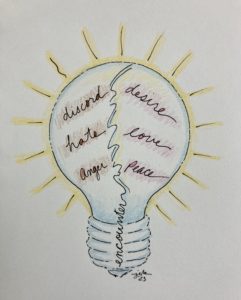
-Artwork © 2025 Jan Ketchel
I define the group soul of now to be the collective soul of all individual souls currently extant in human form on planet Earth. We are the brain center of the Earth, afforded the free will to impact greatly the fate of this planet.
Of course, Mother Nature, the subconscious powerhouse of our group soul, also has us experience the true karma of our decisions. Optimally, our collective will would harmonize with the greater good for all.
Currently, the group soul of our world is in a process of extreme polarization. Conventional wisdom would have these opposing forces come together to reconcile differences in a process of communication, understanding and compromise.
However, such desired union is not yet prepared for, as the warring elements are convinced that success can only be obtained through the total conquest of opposition. For a harmonious union of opposites to occur at the level of the group soul, we must first discover and reconcile with the opposites within ourselves.
If we don’t know ourselves at the depths of our own inner opposites, we are sure to fall prey to the power of projection, where the problem of opposites is resolved through rejecting our neighbor, our projected, forsaken inner opposite.
Nonetheless, we can take advantage of discovering ourselves through the projections that so powerfully, emotionally seize us. For instance, I might notice myself angered at what I see as a highly manipulative, passive-aggressive move by another person. My anger, if I am paying attention, tells me immediately to look within.
As I do my mental inventory, I might discover my own ego power drive that does not like to lose. And with this insight, I shine a light upon the hologram of self, which reveals to me that in the as without of my projections is also the so within of my own psyche.
My ability to identify the true source of my anger, my own power drive, brings me into greater acceptance of my apparent opponent, as I can now see myself in the other. This does not resolve this inner opposition, but it does truly bring it home to roost.
Self acceptance of the unacceptable within makes it more acceptable to acknowledge that everything we are is the same in everyone else. Wisdom comes in knowing how to live those opposites, as in when and where it is best for them to be lived in our lives.
The more we are able to see ourselves in every attitude that comes at us the more we no longer need to be personally offended by the behaviors of others that we ourselves are quite capable of committing, if only in our fantasies. Fantasizing hating our neighbor is quite a potent form of polarization, within and without.
Anger and hatred issue from the solar plexus chakra, the home of our personal power. Inevitably, from this center we find ourselves in a competitive mode with others. The ability to reach the heart center chakra, the place of compassion, allows us to raise our vibration to the higher level of love, truth and wisdom, which lifts us out of the throes of competition.
The heart center also connects us to the wisdom and guidance of the High Self, that which assures us that there are benevolent forces beyond the ego that are in alignment with the greater good, letting us know that we can let go of the need to control, and be in harmony with the greater good of the group soul.
If we are to truly harmonize with the group soul for the greater good of all, we must innerly disarm from overt or covert hostility. When truly detached we are able to shift our energetic posture from yang to yin.
Yin is a magnetic state that attracts people in a positive way because they can feel that they are energetically being accepted, regardless of their views. A yang state, which is assertive, is, of course, equally appropriate at times. This set of opposites, yin and yang, represent a supreme example of opposites, able to express their individuality when appropriate and join in union—the essence of creation—when appropriate.
All efforts to harmonize the opposites within one’s individual soul are powerful contributions to the group soul of now, as it finds its way to the harmony of the greater good of all.
Harmonizing,
Chuck




